The History Book Club discussion
AMERICAN HISTORY
>
JAMESTOWN/WILLIAMSBURG/YORKTOWN - HISTORIC TRIANGLE OF COLONIAL VIRGINIA
date newest »
newest »
 newest »
newest »
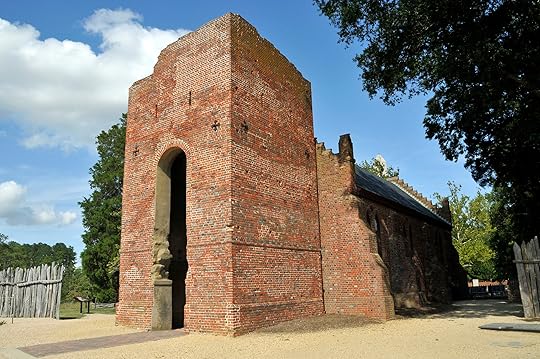
The ruined tower of the 17th century Jamestown Church; the nave was reconstructed in 1907 on the original foundations
Source: Wikipedia
Rebels - Video
Find out how seven generations of European settlers survived against all odds in the establishment of the original American colonies.
Link: https://www.history.com/videos/rebels...
Source: History
Find out how seven generations of European settlers survived against all odds in the establishment of the original American colonies.
Link: https://www.history.com/videos/rebels...
Source: History
The Cradle of the Republic: Jamestown and James River
 by Lyon Gardiner Tyler (no photo)
by Lyon Gardiner Tyler (no photo)
Synopsis:
The first Jamestown history was “The Cradle of the Republic: Jamestown and James River,” written by lawyer and historian Lyon G. Tyler, president of the College of William and Mary when it was published in 1906.
Before Williamsburg, there was Jamestown. From the early 1600's to 1699 Jamestown was indeed, "The Cradle of the Republic". And, those early days were anything but romantic...they were brutal. The first few years were known as the "Starving Time".
And if starving was not enough to worry about, there were the Indians to deal with. If you haven't studied Jamestown, you haven't studied Early Colonial American history.
Filled with many portraits, maps, and signatures. Includes lists of names of earliest inhabitants. Buildings, Forts, and Churches (including tombstone inscriptions), and biographical sketches.
This edition of the original retains the original spellings, and the flavor of this special 1900 work.
It has been carefully edited for scanning errors. This is NOT just pictures of the pages of an old book...this is a carefully optically translated version of the 1900 original. Profusely Illustrated. [EDB Pubs]
 by Lyon Gardiner Tyler (no photo)
by Lyon Gardiner Tyler (no photo)Synopsis:
The first Jamestown history was “The Cradle of the Republic: Jamestown and James River,” written by lawyer and historian Lyon G. Tyler, president of the College of William and Mary when it was published in 1906.
Before Williamsburg, there was Jamestown. From the early 1600's to 1699 Jamestown was indeed, "The Cradle of the Republic". And, those early days were anything but romantic...they were brutal. The first few years were known as the "Starving Time".
And if starving was not enough to worry about, there were the Indians to deal with. If you haven't studied Jamestown, you haven't studied Early Colonial American history.
Filled with many portraits, maps, and signatures. Includes lists of names of earliest inhabitants. Buildings, Forts, and Churches (including tombstone inscriptions), and biographical sketches.
This edition of the original retains the original spellings, and the flavor of this special 1900 work.
It has been carefully edited for scanning errors. This is NOT just pictures of the pages of an old book...this is a carefully optically translated version of the 1900 original. Profusely Illustrated. [EDB Pubs]
 I graduated from York High School, York County, Virgina and received my AB degree in history from the College of William and Mary. I do have some interest in this thread.
I graduated from York High School, York County, Virgina and received my AB degree in history from the College of William and Mary. I do have some interest in this thread.

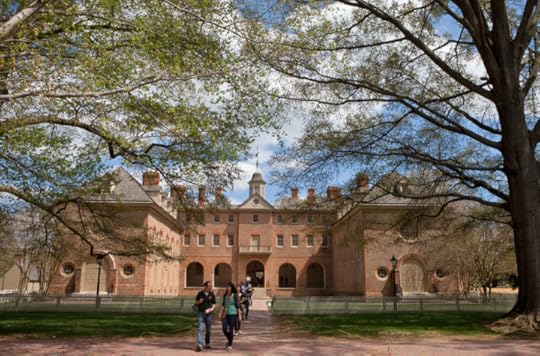
The Sir Christopher Wren building on the William and Mary campus as designed by Christopher Wrenn.
Source: College of William and Mary
 Good Morning, Jeffrey,. Congratulations! And that’s Sir Christopher Wren, architect of St. Paul’s London.
Good Morning, Jeffrey,. Congratulations! And that’s Sir Christopher Wren, architect of St. Paul’s London.Regards,
Andrea
 Andrea wrote: "Good Morning, Jeffrey,. Congratulations! And that’s Sir Christopher Wren, architect of St. Paul’s London.
Andrea wrote: "Good Morning, Jeffrey,. Congratulations! And that’s Sir Christopher Wren, architect of St. Paul’s London.Regards,
Andrea"
Hello Andrea, welcome to this folder. Are there any particular sources that you would like this thread to examine?
 Jeffrey, would you please tell me more about William & Mary? Isn’t it one of the oldest colleges in the Nation?
Jeffrey, would you please tell me more about William & Mary? Isn’t it one of the oldest colleges in the Nation?Regards,
Andrea
Off the coast of Virginia during the Revolutionary War - the French had come to the aid of the colonists in naval battles against the British.
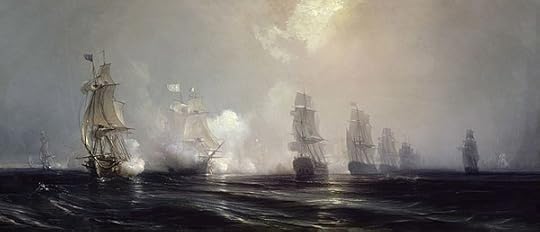 French and British ships battling on the Chesapeake, 3 September 1781
French and British ships battling on the Chesapeake, 3 September 1781
The Royal Navy was deemed the Wooden Walls.
I have attached a good video which gives the account of the Royal Navy preceding the Revolutionary War and the account of the battles off the coast of Virginia:
Here is the ditty - The Wooden Walls of England:
The Wooden Walls of England.
Morning Chronicle and London Advertiser (25 June 1773).
by Henry Green
When Britain on her sea-girt shore,
Her white-rob'd Druids erst address'd;
What Aid (she cry'd) shall I implore,
What best defense, by numbers press'd?
"Tho' hostile nations round thee rise,
(The mystic Oracles reply'd)
And view thine isle with envious eyes,
Their threats defy, their rage deride,
Nor fear Invasions from your adverse Gauls:
Britain's best bulwarks are her WOODEN WALLS.
"Thine Oaks descending to the main,
With floating forts shall stem the tides,
Asserting Britain's wat'ry reign
Where'er her thundering Navy rides:
Nor less to peaceful arts inclin'd,
Where Commerce opens all her stores,
In social bands will league mankind,
And join the sea-divided shores:
Spread then thy sails where Naval Glory calls:
Britain's best bulwarks are her WOODEN WALLS.
Hail, happy isle! what tho' the vales
No vine-impurpled tribute yield,
Nor fann'd with odour-breathing gales,
Nor crops spontaneous glad the field:
Yet Liberty rewards the toil
Of Industry, to labour prone,
Who jocund ploughs the grateful soil,
And reaps the harvest she has sown.
While other realms tyrannic sway inthralls,
Britain's best bulwarks are her WOODEN WALLS."
Thus spake the bearded Seers of yore,
In visions wrapt of Britain's fame
Ere yet Iberia felt her pow'r,
Or Gallia trembled at her name.
O! that my muse inspir'd could sing
The praises to her Heroes due,
Would heaven-born genius imp her wing,
Pleas'd, she'd the glorious theme pursue!
Then should my verse record great GEORGE'S reign,
Who stretch'd from Pole to Pole his wide domain.
Note:
Four Prior stanzas, the lines shortened by a foot in a lyric variation of this popular form. Green's poem became very popular after it was set by the composer Thomas Arne, with a different conclusion: "Ere yet Columbus dar'd t' explore | New regions rising from the main; | From sea to sea, from shore to shore, | Bear then, ye winds, the solemn strain! | This sacred truth, an awe-struck world appals, | Britain's best bulwarks are her Wooden Walls" Universal Magazine 70 (June 1782) 322. Perhaps the stanza was selected in deference to Ramillies, the name of Green's ship and the subject of Matthew Prior's poem.
Headnote: "The following was presented to the King at his Levee on Monday, by the Author. The Wooden Walls of England, an Ode, by Henry Green, Purser of his Majesty's Ship Ramillies."
Link: http://spenserians.cath.vt.edu/TextRe...
More:
History of the Royal Navy - Wooden Walls (1600-1805)
Link: https://youtu.be/Ze8Y1gokHyA
Link: https://en.wikipedia.org/wiki/Naval_b...
 by U.S. Government (no photo)
by U.S. Government (no photo)
Link to Internet Archive: https://archive.org/details/NavalDocu...
Sources: Youtube, Internet Archive, English Poetry 1579-1830: Spenser and the Tradition
 French and British ships battling on the Chesapeake, 3 September 1781
French and British ships battling on the Chesapeake, 3 September 1781The Royal Navy was deemed the Wooden Walls.
I have attached a good video which gives the account of the Royal Navy preceding the Revolutionary War and the account of the battles off the coast of Virginia:
Here is the ditty - The Wooden Walls of England:
The Wooden Walls of England.
Morning Chronicle and London Advertiser (25 June 1773).
by Henry Green
When Britain on her sea-girt shore,
Her white-rob'd Druids erst address'd;
What Aid (she cry'd) shall I implore,
What best defense, by numbers press'd?
"Tho' hostile nations round thee rise,
(The mystic Oracles reply'd)
And view thine isle with envious eyes,
Their threats defy, their rage deride,
Nor fear Invasions from your adverse Gauls:
Britain's best bulwarks are her WOODEN WALLS.
"Thine Oaks descending to the main,
With floating forts shall stem the tides,
Asserting Britain's wat'ry reign
Where'er her thundering Navy rides:
Nor less to peaceful arts inclin'd,
Where Commerce opens all her stores,
In social bands will league mankind,
And join the sea-divided shores:
Spread then thy sails where Naval Glory calls:
Britain's best bulwarks are her WOODEN WALLS.
Hail, happy isle! what tho' the vales
No vine-impurpled tribute yield,
Nor fann'd with odour-breathing gales,
Nor crops spontaneous glad the field:
Yet Liberty rewards the toil
Of Industry, to labour prone,
Who jocund ploughs the grateful soil,
And reaps the harvest she has sown.
While other realms tyrannic sway inthralls,
Britain's best bulwarks are her WOODEN WALLS."
Thus spake the bearded Seers of yore,
In visions wrapt of Britain's fame
Ere yet Iberia felt her pow'r,
Or Gallia trembled at her name.
O! that my muse inspir'd could sing
The praises to her Heroes due,
Would heaven-born genius imp her wing,
Pleas'd, she'd the glorious theme pursue!
Then should my verse record great GEORGE'S reign,
Who stretch'd from Pole to Pole his wide domain.
Note:
Four Prior stanzas, the lines shortened by a foot in a lyric variation of this popular form. Green's poem became very popular after it was set by the composer Thomas Arne, with a different conclusion: "Ere yet Columbus dar'd t' explore | New regions rising from the main; | From sea to sea, from shore to shore, | Bear then, ye winds, the solemn strain! | This sacred truth, an awe-struck world appals, | Britain's best bulwarks are her Wooden Walls" Universal Magazine 70 (June 1782) 322. Perhaps the stanza was selected in deference to Ramillies, the name of Green's ship and the subject of Matthew Prior's poem.
Headnote: "The following was presented to the King at his Levee on Monday, by the Author. The Wooden Walls of England, an Ode, by Henry Green, Purser of his Majesty's Ship Ramillies."
Link: http://spenserians.cath.vt.edu/TextRe...
More:
History of the Royal Navy - Wooden Walls (1600-1805)
Link: https://youtu.be/Ze8Y1gokHyA
Link: https://en.wikipedia.org/wiki/Naval_b...
 by U.S. Government (no photo)
by U.S. Government (no photo)Link to Internet Archive: https://archive.org/details/NavalDocu...
Sources: Youtube, Internet Archive, English Poetry 1579-1830: Spenser and the Tradition
 Andrea wrote: "Jeffrey, would you please tell me more about William & Mary? Isn’t it one of the oldest colleges in the Nation?
Andrea wrote: "Jeffrey, would you please tell me more about William & Mary? Isn’t it one of the oldest colleges in the Nation?Regards,
Andrea"
Yes. The College notes that the first effort to create an institution of higher learning in Virginia, then called the College of Henrico, took place in 1618. At that time a school was constructed and opened but it was entirely destroyed by the Indian uprising in 1622. A royal charter was issued in 1693 and construction begun at its present site in 1695 at what was then called Middle Plantation and is today know as Williamsburg. The college is today a university but retains its historic name as the College of William and Mary. The history department included the Omohudro Institute and the William and Mary Quarterly. The College's divisions include the Marshall-Wythe School of law and the Virginia Institute of Marine Science at Gloucester Point near Yorktown.
Source: College of William and Mary
Link: https://www.wm.edu/

Arial view of campus with sunken garden in background.
Source: College of William and Mary
 Oh my, Jeffrey, that gives me goose-bumps ... what a privilege it must be to attend such a venerable institution ...
Oh my, Jeffrey, that gives me goose-bumps ... what a privilege it must be to attend such a venerable institution ... Regards,
Andrea
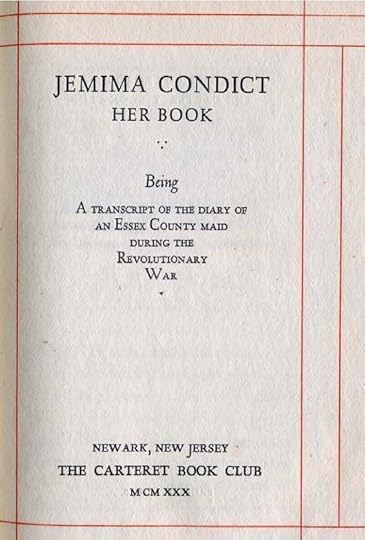
"For many people in Colonial America, the Revolution was a transforming event. Artisans, poor farmers, women, and African-Americans, far removed from the seats of power, came to believe they were full participants in a struggle of sweeping historical significance. Countless journals, diaries, and letters document the metamorphosis of loyal colonial British subjects into either indignant Loyalists or independent American citizens. Although some people tried to remain neutral or uninvolved, local concerns usually convinced them to choose sides. When the war itself drew near, even the most steadfast individuals took an interest in the conflict. However, not every American became swept up in the Revolutionary struggle. Jemima Condict, the daughter of a middling Essex County farmer in northern New Jersey, lived within easy reach of the British Army stationed in New York.
Opposing armies marched through Essex County on numerous occasions, and British foraging parties placed Jemima’s home at the front line of the war. There were also siginificant personal reasons for the war to become a focal point of her attention. Her father Daniel was a private in the militia and later in the Continental Army, her uncle David was a Lieutenent Colonel in the Continental Army, and her cousin John was a militia surgeon. Her future husband, Aaron Harrison, was a militia private. Thus, physically, militarily, and emotionally, Jemima lived at the heart of the swirling tempest. Yet throughout the war, the events of the Revolution rarely held her full attention.
Jemima Condict was born on August 24, 1755 as the third of eight children. Her parents, Ruth and Daniel Condict, were middling people of Welsh descent, and her grandfather, Samuel Condict, had been instrumental in the founding of her northern New Jersey community. She regularly attended the local church and the settlement’s schoolhouse, where she studied the bible. Her faith became immensely important to her. When she was seventeen, Jemima took the unused portion of her school exercise book and began a journal. Her writings usually turned to passages of Scripture she had either read or heard, especially those in the weekly services of Mr. Chapman, the local minister.
Of particular concern to Jemima was her own vanity, and whether or not it was proper for first cousins to marry. She had fallen in love with her cousin Aaron Harrison, and at one point she asked her mother, Ruth, for her opinion on the matter. Her mother proved evasive, but Jemima was in earnest. She had become very agitated about whether such a union was forbidden by God. After pushing her mother for an answer, Ruth responded that “She had thought a great Deal about It & for her part Could Not see but that It was right.” As far as it being forbidden, “She did not think there wos such a Place In the Bible,” and “Said Likewise that she Did Not See what Ministers Should marry them for if twas.”
Occasionally the events of the Revolution would evoke a comment from Jemima.
Most of these passages concerned local events, though not all. In 1774, when radical agitation over the Tea Act had led to the non-importation agreements in the American mercantile community, Jemima commented that “It seems we have troublesome times a Coming for there is great Disturbance a Broad in the earth.” Of the cause however, she only understood that “it is tea,” and “So if they will Quarrel about such a trifling thing as that What must we expect But war & I think or least fear it will be so.”
Clearly, the Revolutionary movement had not politicized Jemima. Patriots were outraged over the Tea Act because it represented taxation without representation in Parliament; the commodity itself, while important in colonial America, was of secondary concern. Yet for Jemima, going to war over the price of tea in America seemed quite absurd.
Remainder of article: https://www.historyisfun.org/learn/le...
Source: Jamestown Settlement and American Revolution Museum at Yorktown
More:
https://www.njstatelib.org/wp-content...
https://njwomenshistory.org/discover/...
http://inthewordsofwomen.com/?cat=437
https://www.findagrave.com/memorial/6...
https://books.google.com/books?id=h-6...
https://www.revolutionarywarnewjersey...
(no image) Weathering the Storm: Women of the American Revolution by Elizabeth Evans (no photo)
 by Alfred Hoyt Bill (no photo)
by Alfred Hoyt Bill (no photo) by Margaret Morris (no photo)
by Margaret Morris (no photo) by Barbara J. Mitnick (no photo)
by Barbara J. Mitnick (no photo)
 Bentley, your post on Jemima Condict reminded me of the painting by Pieter Bruegel of the Fall of Icarus ... a man in the foreground is plowing, others are going about their daily tasks, and off in the far distance a tiny figure plunges into the water ... I believe W. H. Auden wrote a poem about it ... we rarely focus on what is truly historic when we are caught up in the moment ...
Bentley, your post on Jemima Condict reminded me of the painting by Pieter Bruegel of the Fall of Icarus ... a man in the foreground is plowing, others are going about their daily tasks, and off in the far distance a tiny figure plunges into the water ... I believe W. H. Auden wrote a poem about it ... we rarely focus on what is truly historic when we are caught up in the moment ...Regards,
Andrea
 by
by
 W.H. Auden
W.H. Auden
Andrea, very true - I have included it below. Thank you for your reminder of the connection.

Landscape with the Fall of Icarus
"One of Bruegel's best-known paintings, Landscape with the Fall of Icarus incorporates a landscape in the foreground with an expansive seascape stretching away towards the horizon. Closest to us, a farmer pushes a plow and horse. To his right, on a lower plateau of land, a shepherd tends to his flock. In the right foreground, a fisherman with his back to the viewer casts his net at the water's edge, while close to the shore in the bottom-right, two legs kick in the air: a comically minute reference to the titular narrative, which therefore seems to unfold in the background of the scene.
This is one of two paintings by Bruegel, which depict the story of Icarus as told in Ovid's Metamorphoses. These were the only two works which Bruegel created on mythological themes, in marked contrast to his contemporaries' focus on heroic narratives. The story revolves around the death of Icarus, the boy who wanted so badly to fly that he constructed wings out of wax and feathers. Failing to heed his father's warning not to fly too close to the sun, his wings melted and he plunged into the sea. We might expect that this tragic denouement would form the focal point of Bruegel's painting, but instead it becomes one incident woven into an all-encompassing representation of common rural life, the demise of the hero rendered almost laughable in its head-first ignominy. The composition is both irreverent and subtly philosophically resonant, expressing a clear skepticism for the bombastic mythological painting that had dominated the previous century of Renaissance art.
This work has been the subject of much moral speculation, revolving especially around the various figures who remain ignorant of Icarus's plight, only the shepherd glancing up towards the sky, and not even towards the relevant spot. The displacement of Icarus from center-stage has been interpreted as a directive to remain focused on one's own daily life. William Dello Russo has even suggested that the painting may illustrate a well-known Netherlandish expression, "one does not stay the plow for one who is dying." Landscape with the Fall of Icarus was given its most famous twentieth-century treatment by the poet W.H. Auden, whose poem Musée des Beaux Arts (1938) considers how suffering and personal drama take place in a wider context of ongoing life."
Oil on canvas - Musées Royaux des Beaux-Arts, Brussels, Belgium
Source: The Art Story

Landscape with the Fall of Icarus
"One of Bruegel's best-known paintings, Landscape with the Fall of Icarus incorporates a landscape in the foreground with an expansive seascape stretching away towards the horizon. Closest to us, a farmer pushes a plow and horse. To his right, on a lower plateau of land, a shepherd tends to his flock. In the right foreground, a fisherman with his back to the viewer casts his net at the water's edge, while close to the shore in the bottom-right, two legs kick in the air: a comically minute reference to the titular narrative, which therefore seems to unfold in the background of the scene.
This is one of two paintings by Bruegel, which depict the story of Icarus as told in Ovid's Metamorphoses. These were the only two works which Bruegel created on mythological themes, in marked contrast to his contemporaries' focus on heroic narratives. The story revolves around the death of Icarus, the boy who wanted so badly to fly that he constructed wings out of wax and feathers. Failing to heed his father's warning not to fly too close to the sun, his wings melted and he plunged into the sea. We might expect that this tragic denouement would form the focal point of Bruegel's painting, but instead it becomes one incident woven into an all-encompassing representation of common rural life, the demise of the hero rendered almost laughable in its head-first ignominy. The composition is both irreverent and subtly philosophically resonant, expressing a clear skepticism for the bombastic mythological painting that had dominated the previous century of Renaissance art.
This work has been the subject of much moral speculation, revolving especially around the various figures who remain ignorant of Icarus's plight, only the shepherd glancing up towards the sky, and not even towards the relevant spot. The displacement of Icarus from center-stage has been interpreted as a directive to remain focused on one's own daily life. William Dello Russo has even suggested that the painting may illustrate a well-known Netherlandish expression, "one does not stay the plow for one who is dying." Landscape with the Fall of Icarus was given its most famous twentieth-century treatment by the poet W.H. Auden, whose poem Musée des Beaux Arts (1938) considers how suffering and personal drama take place in a wider context of ongoing life."
Oil on canvas - Musées Royaux des Beaux-Arts, Brussels, Belgium
Source: The Art Story
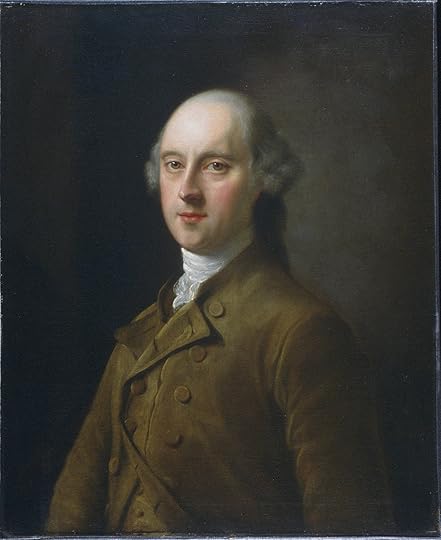
Known as the “Psalm Singer” for his piety, William Legge, Lord Dartmouth, served as the British colonial secretary in the early months of the American rebellion. Although hardly a warmonger, he believed that prideful insurgents disobeyed both their British masters and their God - He was the namesake of Dartmough College (which originally was supposed to be a school for Native Americans) - and Lord North was his step-brother - Nathaniel Hone I, William Legge (1731–1801), Second Earl of Dartmouth, oil on canvas, 1777. (Courtesy of Hood Museum of Art, Dartmouth College. Gift of Earle W. Newton, P.960.100)
"Lord Dartmouth was Secretary of State for the Colonies from 1772 to 1775. Lord Dartmouth's arrival in the Colonies was celebrated by Phillis Wheatley's famous poem, "To the Right Honourable William, Earl of Dartmouth."
It was Lord Dartmouth who, in 1764, at the suggestion of Thomas Haweis, recommended John Newton, the former slave trader and author of "Amazing Grace", to Edmund Keene, the Bishop of Chester. He was instrumental in Newton's acceptance for the Anglican ministry.
In 1772, in correspondence with Sir William Johnson, the Superintendent of Northern Indian Affairs in America, he suggested that there was no reasonable way the British Government could support new trade regulations with the Indians. He sympathised with Johnson's arguments but stated the Colonies did not seem inclined to concur with any new regulations.
Remainder of Article:
https://en.wikipedia.org/wiki/William...
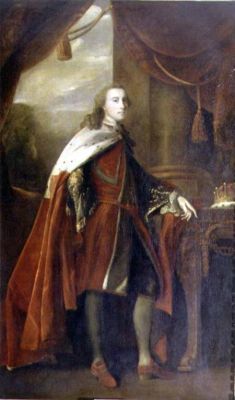
Sources: Atkinson, Rick. The British Are Coming (The Revolution Trilogy) (p. 564). Henry Holt and Co.. Kindle Edition, Wikipedia
More:
http://thepeerage.com/p2576.htm#i25759
https://en.wikisource.org/wiki/Legge,...
https://www.britannica.com/biography/...
http://www.ouramericanrevolution.org/...
https://www.masshist.org/revolution/r...
https://www.vnews.com/Dartmouth-heir-...
https://www.youtube.com/watch?v=z5gsY...
(no image) Lord Dartmouth and the American Revolution (no photo)
 by Clare Hopkins (no photo)
by Clare Hopkins (no photo) by
by
 Samuel B. Griffith
Samuel B. Griffith
 Bentley,thank you for the rescue! It’s comforting to know that Goodreads really does have a photo of W. H. Auden. Also, thank you for finding the piece of art.
Bentley,thank you for the rescue! It’s comforting to know that Goodreads really does have a photo of W. H. Auden. Also, thank you for finding the piece of art.Regards,
Andrea
 A good contemporary, general history for the founding of Jamestown is: A Land as God Made It by James Horn. The text is very readable for the non-historian. Although there is not a books referenced page there are almost 30 pages of notes. The book begins with a look back upon Spanish efforts to found a mission in the area.
A good contemporary, general history for the founding of Jamestown is: A Land as God Made It by James Horn. The text is very readable for the non-historian. Although there is not a books referenced page there are almost 30 pages of notes. The book begins with a look back upon Spanish efforts to found a mission in the area.A Land as God Made It
 by James Horn (no photo)
by James Horn (no photo)Synopsis:
Jamestown -the first permanent English settlement in North America, after the disappearance of the Roanoke colony-is often given short shrift in histories of America. Founded thirteen years before the Mayflower landed, Jamestown occupies less space in our cultural memory than the Pilgrims of Plymouth.
But as historian James Horn points out, many of the key tensions of Jamestown's early years became central to American history, for good and for ill: Jamestown introduced slavery into English-speaking North America; it became the first of England's colonies to adopt a representative government; and, it was the site of the first clashes between whites and Indians over territorial expansion.
Jamestown began the tenuous, often violent, mingling of different peoples that came to embody the American experience. A Land as God Made It puts the Jamestown experience in the context of European geopolitics, giving prominence to the Spanish threat to extinguish the colony at the earliest opportunity. Jamestown-unlike Plymouth or Massachusetts-was England's bid to establish an empire to challenge the Spanish. With unparalleled knowledge of Jamestown's role in early American history, James Horn has written the definitive account of the colony that gave rise to America.
 1619: Jamestown and the Forging of American Democracy
1619: Jamestown and the Forging of American Democracy by James Horn (no photo)
by James Horn (no photo)Synopsis:
An extraordinary year in which American democracy and American slavery emerged hand in hand.
Along the banks of the James River, Virginia, during an oppressively hot spell in the middle of summer 1619, two events occurred within a few weeks of each other that would profoundly shape the course of history. In the newly built church at Jamestown, the General Assembly--the first gathering of a representative governing body in America--came together. A few weeks later, a battered privateer entered the Chesapeake Bay carrying the first African slaves to land on mainland English America.
In 1619, historian James Horn sheds new light on the year that gave birth to the great paradox of our nation: slavery in the midst of freedom. This portentous year marked both the origin of the most important political development in American history, the rise of democracy, and the emergence of what would in time become one of the nation's greatest challenges: the corrosive legacy of racial inequality that has afflicted America since its beginning.
Books mentioned in this topic
1619: Jamestown and the Forging of American Democracy (other topics)A Land As God Made It: Jamestown and the Birth of America (other topics)
Selected Poetry of W. H. Auden (other topics)
Trinity: 450 Years of an Oxford College Community (other topics)
The War for American Independence: From 1760 to the Surrender at Yorktown in 1781 (other topics)
More...
Authors mentioned in this topic
James Horn (other topics)James Horn (other topics)
Clare Hopkins (other topics)
Samuel B. Griffith II (other topics)
W.H. Auden (other topics)
More...




Artistic Rendition of Colonial Jamestown, Virginia - 1614
The Jamestown settlement in the Colony of Virginia was the first permanent English settlement in the Americas.
It was located on the northeast bank of the James (Powhatan) River about 2.5 mi (4 km) southwest of the center of modern Williamsburg. It was established by the Virginia Company of London as "James Fort" on May 4, 1607 O.S.; (May 14, 1607 N.S.),[3] and was considered permanent after a brief abandonment in 1610.
It followed several failed attempts, including the Lost Colony of Roanoke, established in 1585 on Roanoke Island. Jamestown served as the colonial capital from 1616 until 1699.
Colonial Jamestown About 1614
The settlement was located within the country of Tsenacommacah, which belonged to the Powhatan Confederacy, and specifically in that of the Paspahegh tribe. The natives initially welcomed and provided crucial provisions and support for the colonists, who were not agriculturally inclined. Relations quickly soured, and the colonists would annihilate the Paspahegh in warfare within four years.
Despite the dispatch of more settlers and supplies, including the 1608 arrival of eight Polish and German colonists and the first two European women, more than 80 percent of the colonists died in 1609–10, mostly from starvation and disease.
In mid-1610, the survivors abandoned Jamestown, though they returned after meeting a resupply convoy in the James River.
In August 1619, the first recorded slaves from Africa to British North America arrived in what is now Old Point Comfort near the Jamestown colony, on a British privateer ship flying a Dutch flag.
The approximately 20 Africans from the present-day Angola had been removed by the British crew from a Portuguese slave ship, the "São João Bautista". They most likely worked in the tobacco fields as slaves under a system of race-based indentured servitude. The modern conception of slavery in the colonial United States was formalized in 1640 (the John Punch hearing) and was fully entrenched in Virginia by 1660.
The London Company's second settlement in Bermuda claims to be the site of the oldest town in the English New World, as St. George's, Bermuda was officially established in 1612 as New London, whereas James Fort in Virginia was not converted into James Towne until 1619, and further did not survive to the present day.
In 1676, Jamestown was deliberately burned during Bacon's Rebellion, though it was quickly rebuilt. In 1699, the colonial capital was moved to what is today Williamsburg, Virginia; Jamestown ceased to exist as a settlement, and remains today only as an archaeological site.
Today, Jamestown is one of three locations composing the Historic Triangle of Colonial Virginia, along with Williamsburg and Yorktown, with two primary heritage sites. Historic Jamestowne is the archaeological site on Jamestown Island and is a cooperative effort by Jamestown National Historic Site (part of Colonial National Historical Park) and Preservation Virginia. Jamestown Settlement, a living history interpretive site, is operated by the Jamestown Yorktown Foundation, a state agency of the Commonwealth of Virginia.
Remainder of article:
https://en.wikipedia.org/wiki/Jamesto...
Source: Wikipedia